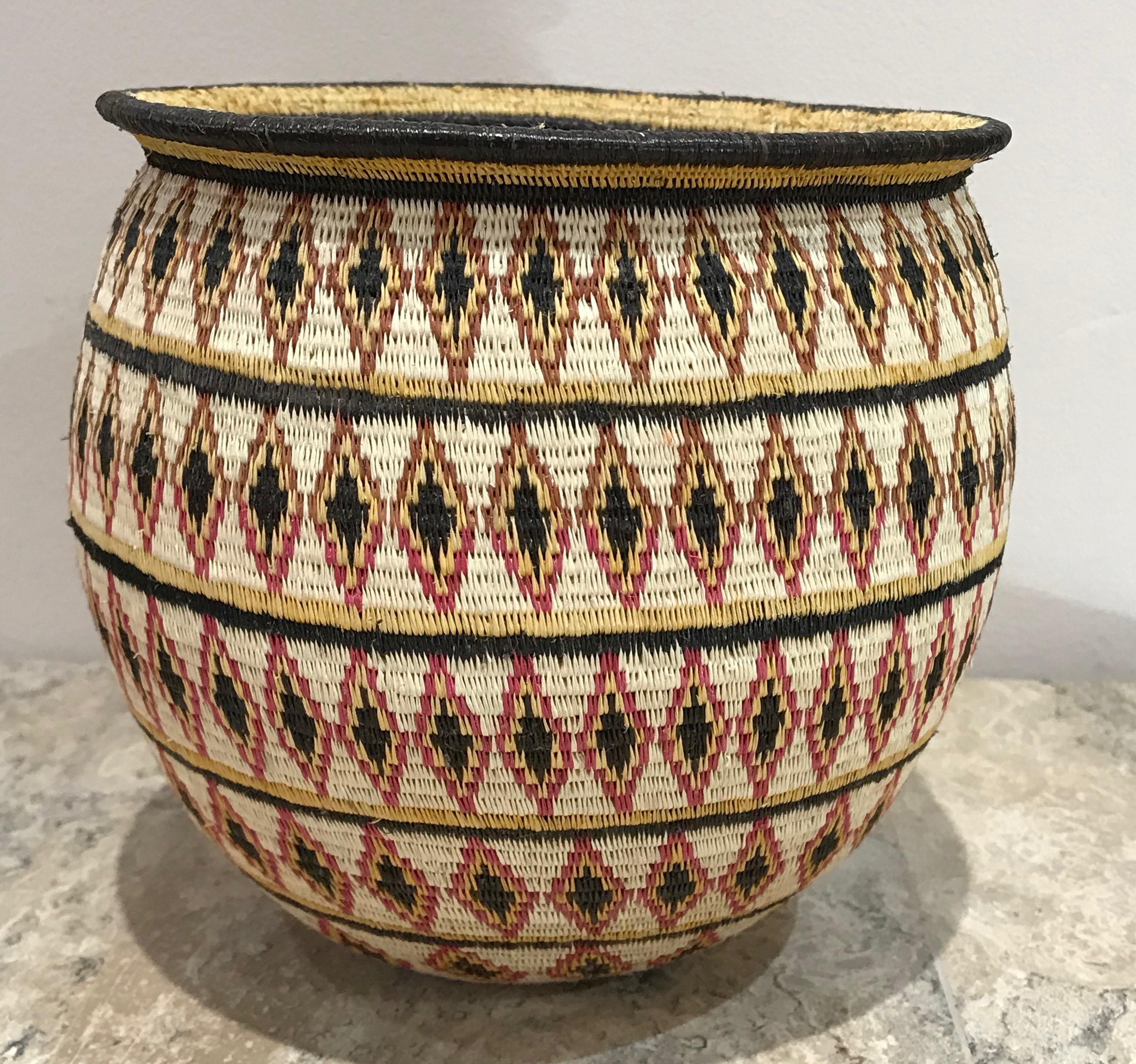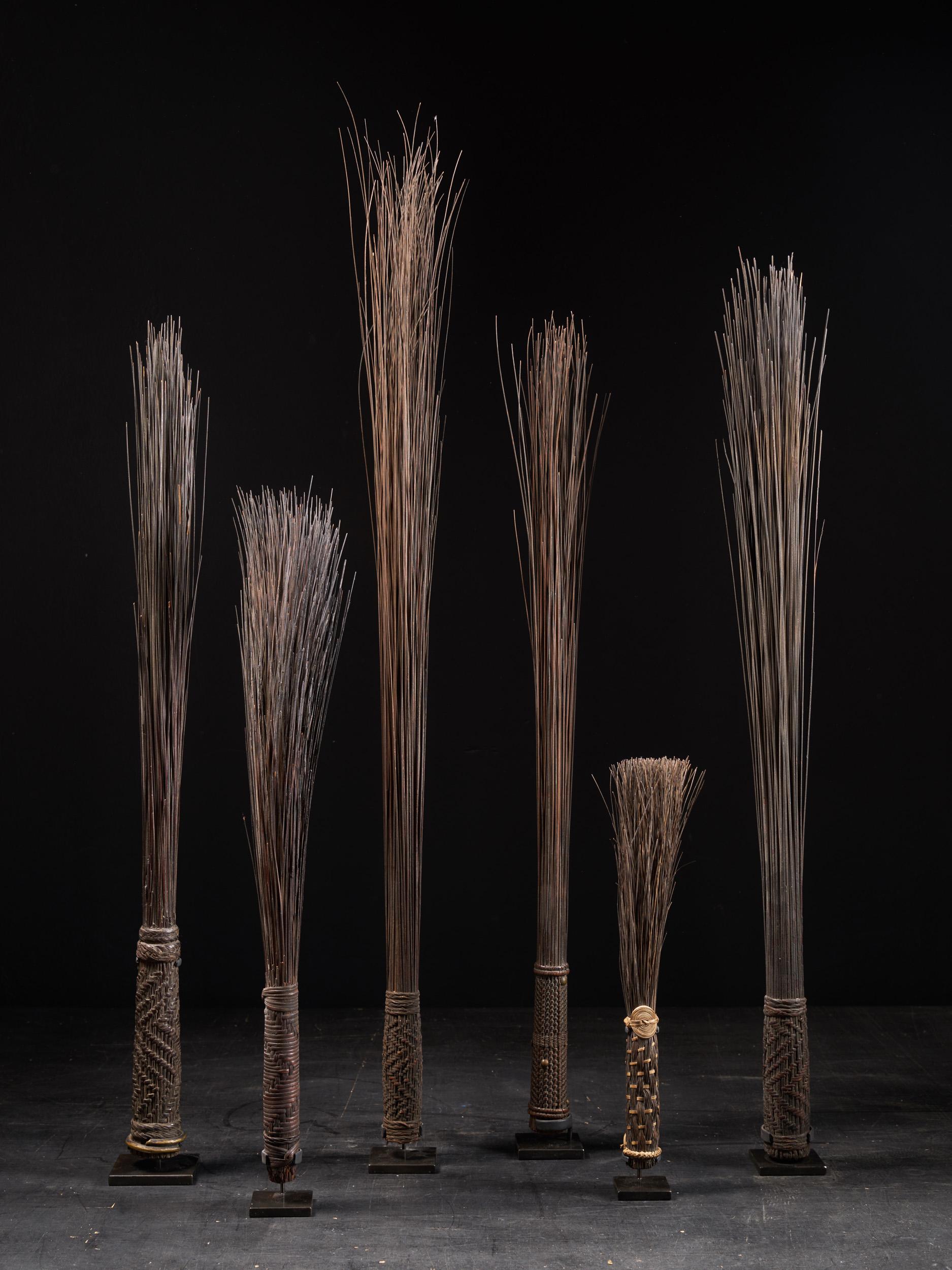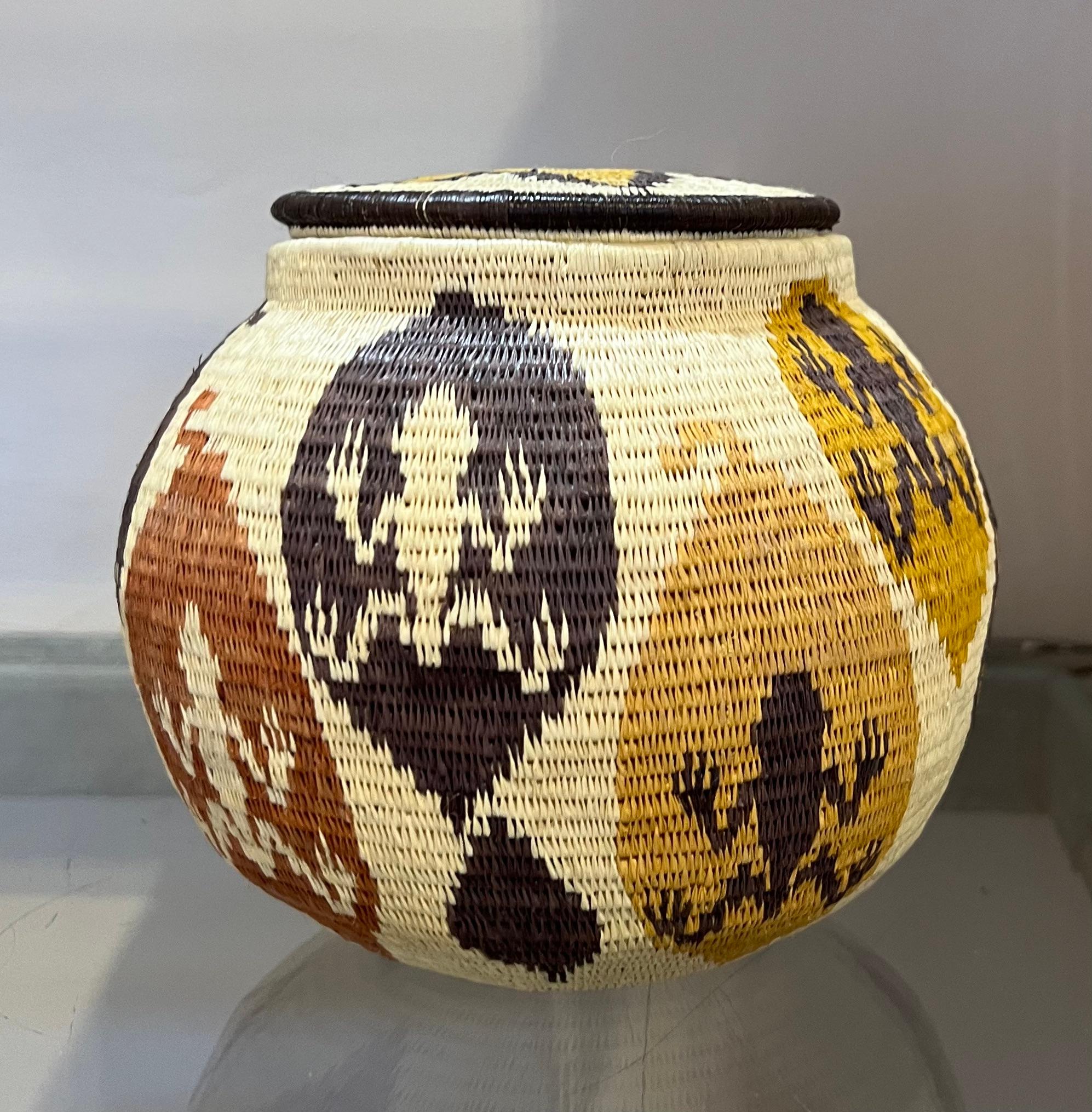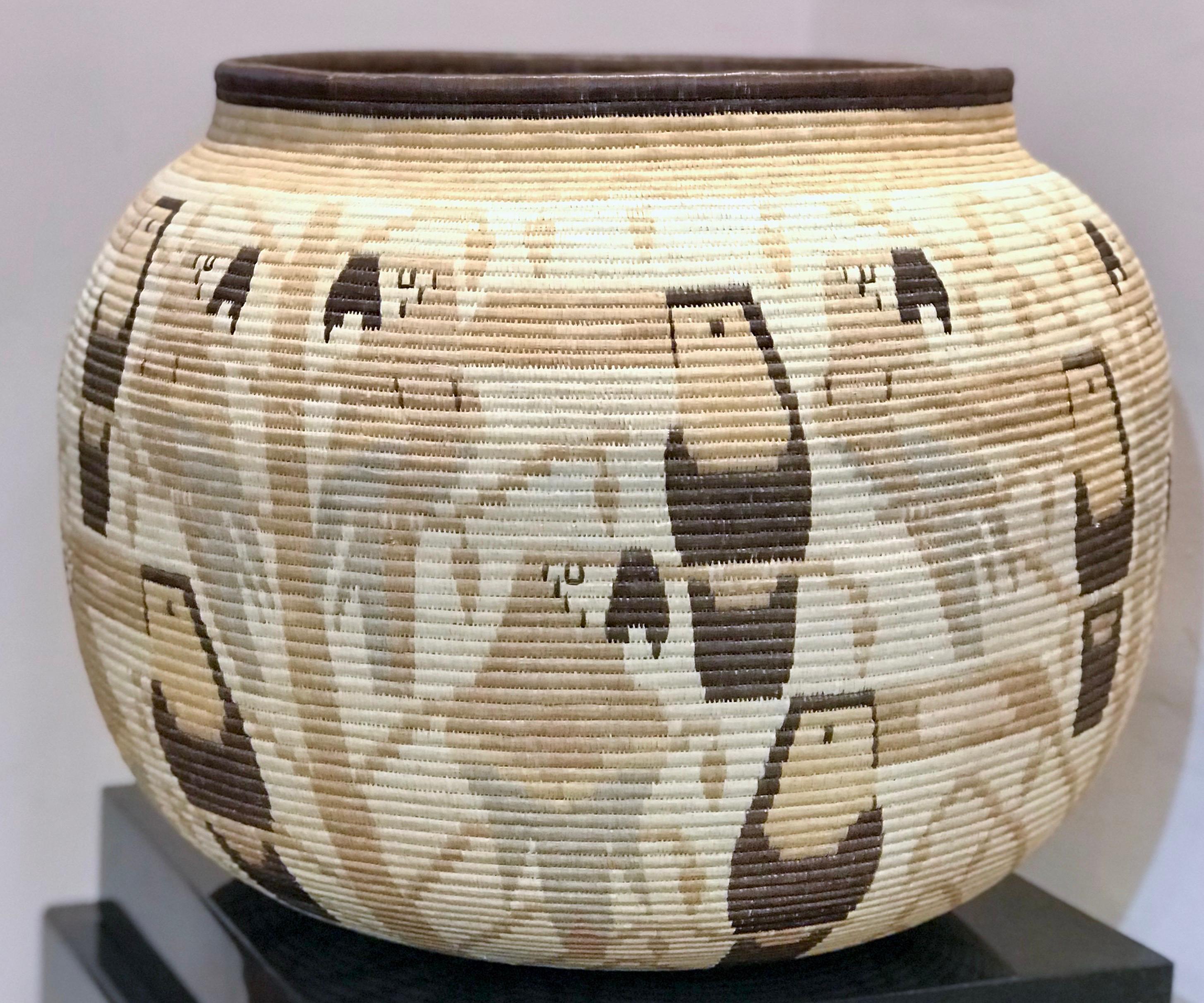Items Similar to Selection of 7 Cache-Sexe made of Palm Leaf with natural fibres
Want more images or videos?
Request additional images or videos from the seller
1 of 5
UnknownSelection of 7 Cache-Sexe made of Palm Leaf with natural fibresUnknown
Unknown
About the Item
Back aprons (negbe, pl. egbe) were trendy among upper-class Mangbetu women at the turn of the twentieth century. This distinctive kidney-shaped ornament pad was built up of intricately layered banana leaves. Worn on special occasions, egbe were affixed to the lower back by a girdle that would maintain a fibre extension into the hollow near the base of the spine, what an early witness to these ornaments described as "a little apron of doubtful effect" was not so much meant to cover the women's buttocks but rather to echo elegantly the shape of the distinctive Mangbetu halo-shaped hairdo, an elaborate conical construction that expended at the back of the head. Banana leaves and raffia cordage.
- Creation Year:Unknown
- Dimensions:Height: 6.7 in (17 cm)Width: 3.15 in (8 cm)Depth: 1.19 in (3 cm)
- Medium:
- Movement & Style:
- Period:
- Condition:
- Gallery Location:brussel, BE
- Reference Number:
About the Seller
5.0
Vetted Seller
These experienced sellers undergo a comprehensive evaluation by our team of in-house experts.
1stDibs seller since 2021
13 sales on 1stDibs
Typical response time: 4 hours
- ShippingRetrieving quote...Ships From: leuven, Belgium
- Return PolicyA return for this item may be initiated within 3 days of delivery.
More From This SellerView All
- Mbole People, RDC, Chief Scepters Collection made of Palmtree Leaf MidribsLocated in brussel, BEThe Sceptres are made of the Midrib of Palm tree leaves. They were used by the Lilwaa Secret Society of the Mbole Tribe members who live in the South-We...Category
19th Century Tribal More Art
MaterialsOrganic Material
- Ancient Red Stone Village Millstone, Most probably from Ghana.Located in brussel, BEMillstones are used for grinding wheat and other grains. Initially, people used a rubbing stone to grind the wheat manually on a simple flat grinding stone. Later they grind the grai...Category
20th Century Tribal More Art
MaterialsStone
- Huge 82 cm Pinkish Quartz Crystal covered rockLocated in brussel, BEQuartz crystal is a power stone that's prized as a healing stone - one of the most powerful of the mineral kingdom. Stone of innocence and discovery, pink quartz nurtures self-love and respect of others. This beautiful pink quartz crystal...Category
18th Century Tribal Abstract Sculptures
MaterialsPrecious Stone
- A pair of Early Native Tribal South Oceanic Ceremonial decorated AdzeLocated in brussel, BEAn adze is a cutting tool similar to an axe but with a cutting edge perpendicular to the handle rather than parallel. Prehistoric Māori adzes from New Zealand, used for wood carving,...Category
20th Century Tribal More Art
MaterialsWood
- Two Anthropomorpic Pipe Bowls of the Yaka, DCRLocated in brussel, BEThe Yaka people (also known as the Bayaka) live in the wooded plateau and savanna areas in the southwest of the Democratic Republic of Congo, along the Kwango and Wamba rivers. The o...Category
20th Century Tribal More Art
MaterialsWood
- Pair of 19th C Inuit Male Statues carved in Walrus TuskLocated in brussel, BEThis pair is a fine example of ivory carving done by Inuit natives; Native Americans who live within and just below the Arctic Circle. Each year they procured a substantial amount of ivory from their walrus kills. The raw ivory was usually thrown on top of their huts to weather and properly season. Proper seasoning caused the ivory to dry from the inside out and thus rarely cracks. Hand-made tools were improvised for carving the ivory and bow-string hand drills were also in use. Ivory carving has been practiced by the Inuit for over 2,000 years and traditionally only Inuit men were allowed to carve objects out of ivory, bone, and wood. Artists found their inspiration in daily life and the natural world around them. Ivory items made from walrus tusks...Category
19th Century More Art
MaterialsOrganic Material
You May Also Like
- Parrot basket, Wounaan Tribe Darien Rainforest Panama, red, yellow, black, whiteLocated in Santa Fe, NMParrot basket, Wounaan Tribe Darien Rainforest Panama, red, yellow, black, whiteCategory
1990s Tribal More Art
MaterialsOrganic Material
- Basket, Wounaan Tribe Panama Darien Rainforest, gold, black, red, whiteLocated in Santa Fe, NMBasket, Wounaan Tribe Panama Darien Rainforest, gold, black, red, whiteCategory
1990s Tribal Mixed Media
MaterialsOrganic Material
- Puma Plaque, Wounaan, Darien Rainforest, Basket, Black, white, red, handwovenLocated in Santa Fe, NMPuma Plaque, Wounaan, Darien Rainforest, Basket, Black, white, red, handwovenCategory
2010s Tribal More Art
MaterialsOrganic Material
- Frog and Spider Basket, Panama Rain Forest, Wounaan Tribe, handwoven, white, redLocated in Santa Fe, NMFrog and Spider Basket, Panama Rain Forest, Wounaan Tribe, handwoven, white, redCategory
2010s Tribal Mixed Media
MaterialsOrganic Material
- Basket, Parrot, Toucan designs Panama Rainforest Wounaan TribeLocated in Santa Fe, NMBasket, Parrot, Toucan designs Panama Rainforest Wounaan Tribe handwoven with palm fibers and vegetal dyes The baskets are made by the Wounaan and Embera Indians from the Darien R...Category
1990s Tribal More Art
MaterialsOrganic Material
- Wounaan Tribe Panama Rainforest Basket black, white geometric rectangleLocated in Santa Fe, NMWounaan Tribe Panama Rainforest Basket black, white geometric rectangle hand woven, palm fibers natural dye Tribal artwork The baskets are made by ...Category
1990s Tribal Mixed Media
MaterialsOrganic Material





